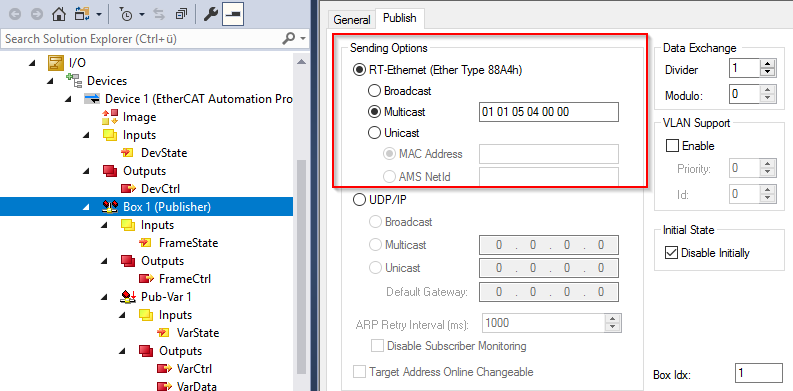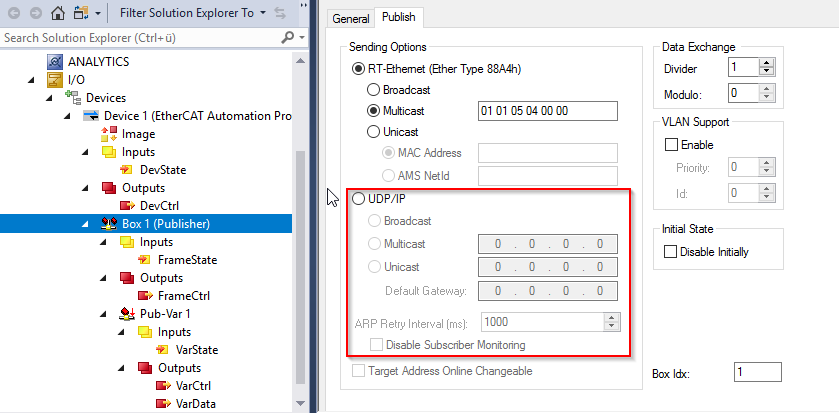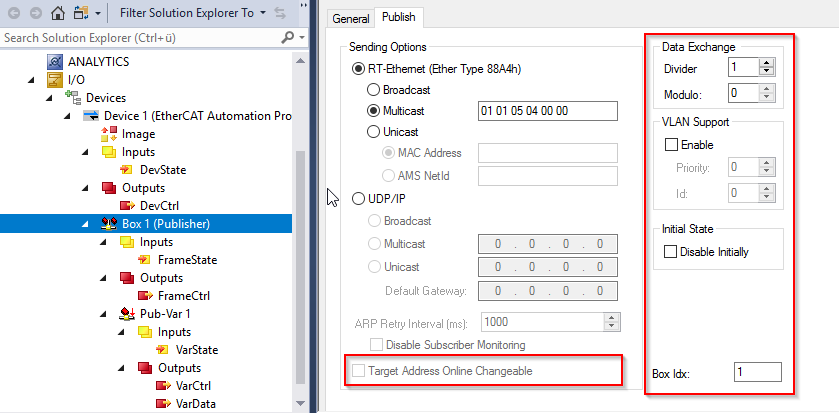Publisher Box
The basic protocol to be used for sending the EAP telegram is set on the configuration page of the Publisher Box (see following illustration) in the Sending Options. The two possible basic protocols Ethernet Protocol und User Datagram Protocol are introduced in the section Network Protocols of the chapter Communication methods in the chapter Basic principles. In each of the two protocols there is a possibility to configure the three different connection methods Broadcast, Multicast or Unicast. In the case of the connection methods Multicast and Unicast, a destination address must also be defined with whose help the addressee(s) can be reached in the network.

Broadcast
A Broadcast telegram is transmitted by one network device to all other devices in the network. Every recipient of a Broadcast message decides for itself whether to process the message or not. A Broadcast at Ethernet Protocol level is sent to the destination MAC address FF:FF:FF:FF:FF:FF and at UDP/IP level to the IP address 255.255.255.255.
Multicast
A Multicast telegram is transmitted by one network device to a selected group of devices in the network. A recipient of a Multicast message must know the Multicast address to which the message was sent and must report it to its network interface card. The network interface card will otherwise discard the Multicast message.
Depending on the basic protocol used, either a Multicast MAC address will be directly configured as the destination address, or a Multicast IP address converted by TwinCAT into a Multicast MAC address will be configured as the destination address. A Multicast IP address must be in the range 224.0.0.0 to 239,255,255,255 (IPv4).
Unicast
A Unicast telegram is transmitted by a network device to precisely one other network device. If the addressing takes place on the basis of the Ethernet Protocol, the MAC address of the receiver is configured as the destination address. Alternatively, the AMS NetID of the receiver can also be configured. If the telegram is sent on the basis of UDP/IP, the IP address of the receiver is configured as the destination address (see following illustration).
Notice | |
Use of broadcast and multicast EAP telegrams sent as Broadcast or Multicast at MAC or IP level cause a higher network load, depending on the cycle time, since they are sent to all network devices! This may cause simple network devices such as printers to crash. With short cycle times all network traffic may become blocked.
|

Disable Subscriber Monitoring
The Subscriber Monitoring mechanism can be deactivated with the help of the option Disable Subscriber Monitoring.
ARP Retry Interval
The time set in the input field ARP Retry Interval specifies the time interval in milliseconds (ms) at which a request is sent to the receiver in order to check its availability.

Target Address Online Changeable
The Target Address Online Changeable option is also only usable with a Unicast. If this function is activated, a further output variable exists for the Publisher in the process image of the EAP device. Depending on which basic protocol is configured, this variable defines an IP address, a MAC address or an AMS NetID. The output variable can be changed with the help of a PLC program. This method can be used to dynamically change the destination address of the configured Publisher (refer also to the conditional outputs in the section Addition of publisher variables).
Data Exchange
The rhythm with which the EAP telegram is sent can be changed with the help of the Data Exchange property (see EAP send mechanism).
 | Data Exchange The Data Exchange property cannot be used if an EL66xx is in use. |
VLAN Support
A fixed route through the VLAN (Virtual Local Area Network) can be specified for the EAP telegram with the help of the VLAN Support property in connection with Managed Switches. If VLAN is enabled, the EAP message is furnished with a VLAN Header. Accordingly, there are two properties for determining the required VLAN and for specifying a priority for the processing of the message within a virtual network:
- VLAN Info ID: defines the ID of the VLAN (range between 0 and 4095),
in which the message is to be sent, and - VLAN Info Priority: defines a priority for the message in the VLAN
(high priority = 7, low priority = 0).
Initial State
With the help of the property “Disable Initially”, you can prevent the publisher from sending packets after starting the system. Sending can subsequently be enabled by setting the FrameState to the value 0.
Box Idx:
Sequential number for the different publishers and subscribers, read-only.